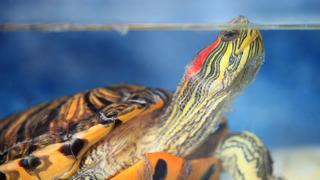Scott McRobert, Ph.D., is Saving Turtles and Their Reputations, Too
Scott McRobert, Ph.D., professor of biology at Saint Joseph’s, is leading new research on the nesting habits of turtles with particular focus on the red-eared slider, an invasive species allegedly threatening the lives of native animals. McRobert is not convinced this is true and is determined to shed light on this topic.

Scott McRobert, Ph.D., has always loved living creatures. Ever since he was a little boy growing up in Virginia, McRobert would spend hours exploring the woods around his home searching for turtles, frogs and other animals to observe and interact with.
This year, McRobert and his students embark upon a new research partnership with the John Heinz National Wildlife Refuge and they are on a mission to save the reputation of the highly invasive red-eared slider turtle species.
Currently a professor of biology at Saint Joseph’s University, McRobert, or “Doc” as his students refer to him, has surrounded himself with towers of terrariums and tanks in the office space and robust laboratories he’s built within the campus’s Science Center. Some of the animals in the lab are involved in long-term research projects, some are rescues from different conservation efforts, some of them are proof-of-life species that are virtually extinct in the world and others are, well, just his pets.
“My labs have kind of taken over the building,” admits McRobert as he rattles off the different areas (including the roof) his research takes place within the Science Center. “When I began teaching here, I was just meant to do research with the Drosophila,” — or fruit flies — “but, eventually, it all came to life around me, which kind of proves that I’m still the same person I was at 10 years old.”
Determined to never put a living being at risk, McRobert and his students work alongside organizations focused on a variety of different conservation and rescue efforts, perhaps most notably saving terrapin hatchlings through a head start program where they spend the first year of their life building strength in his lab before being released into the ocean with better odds for survival.
The research group’s focus on the red-eared slider, however, has been percolating for quite some time.
The red-eared slider came to popularity back in the 1950s when pet shops were allowed to sell turtles. Everyone was buying a turtle for their grandson, nephew, cousin — it seemed like an easy thing to care for and so exotic, too! But turtles can live 60 to 70 years and they can grow quite large.
If I’m doing my job correctly, the turtles in my lab will outlive me.
Scott McRobert, Ph.D.
“If I’m doing my job correctly, the turtles in my lab will outlive me,” says McRobert. “Most people probably didn’t plan on that when buying their kid a pet, so they started to release them back into the wild.”
These days, red-eared sliders are considered an invasive species in every single part of the world — Russia, England, Australia, South America, North America — name a place and the red-eared slider is there, but it definitely shouldn’t be. In Pennsylvania, in fact, if you come across a red-eared slider you are required by law to eliminate it, which means you aren’t even allowed to do research on it.
McRobert contends that the entire concept of invasive species is misunderstood.
“The animals in any ecosystem are always going to adapt to the other species in their environment,” McRobert explains. “Even invasives. That’s how animals survive.”
Because of this, McRobert is determined to prove that red-eared sliders are not a threat to other turtles around them, which is an assumption that has been made without any basis in research.
“Since John Heinz is a refuge, we’re going to be allowed to actually study the red-eared sliders, which no one has done before,” McRobert says. “So we’re going to start by studying the nesting and hatching patterns of all the turtles at John Heinz. And there are so many turtles there!”
John Heinz is a nesting ground for a wide variety of turtle species — painted turtles, map turtles, snapping turtles and more. By studying all the turtles, McRobert and his students aim to prove that red-eared sliders are not out-competing their turtle brethren.
The research team plans to house different groups of hatchlings in the lab, some separated by species and some all together, and continually monitor their growth. Ultimately, this will help them understand whether or not red-eared sliders are affecting the development of other turtle species around them.
“If all the turtle tanks are developing along the same lines, it would suggest that the red-eared sliders are not competing with native turtles in the wild,” says McRobert.
This research has major implications for the red-eared slider, most notably that the species could eventually face a lot less extermination.
This research has major implications for the red-eared slider, most notably that the species could eventually face a lot less extermination.
At the end of the year, most of the hatchlings will then be released back into the refuge where the turtles will continue to thrive in their natural habitat. The red-eared sliders, however, won’t be leaving McRobert’s expansive lab space.
“We aren’t legally allowed to release the red-eared sliders back into the refuge,” notes McRobert. “But I’m more than happy to keep them. They’re real sweethearts.”



